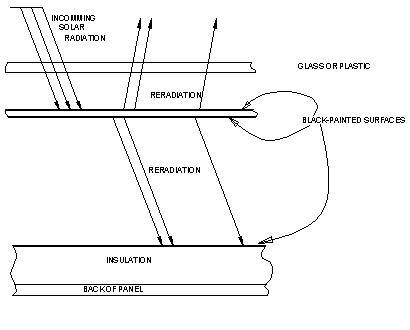
Solar heating makes a lot of sense when you consider that under optimum conditions each square foot of collector surface can receive about 300 BTU per hour from the sun – how much of that your actually get to keep is up to you. Most solar heaters use water or antifreeze as the medium of heat transfer, and for a commercially marketed systems this may be optimum for business. However, there are significant advantages for the home builder in using air.
You don't have to worry about temperature extremes or pressure build up.
If you spring a leak you aren't going to ruin anything
For daytime heating applications you don't need storage or heat exchangers to move the heat from the fluid to the air.
I have successfully transferred solar heated air into water for storage by using an automotive heater core as a heat exchanger.
One of the problems with solar heated air is that whereas in fluid collectors the fluid is essentially the same temperature as the collector surface, in air collectors the surface can get a bit hotter. This can amount to a significant efficiency loss if not properly managed.
The amount of heat radiated by an object is proportional to the fourth power of its absolute temperature. This means that solar panels begin to lose increasingly greater amounts of heat through re-radiation as they approach their highest temperatures.
Expensive Solution:
"Selective coatings" have been developed that reduce some of this re-radiation, but they are expensive enough that they typically add about 30% to the total cost of a solar panel.
Cheap Solution:
When building hot-air style collectors, paint the inside surface of the collector plate black, as well as the outside. The surface facing the collector plate on the inside of the back of the panel must also be a flat black.

This way, about half of the re-radiated energy is sent deeper into the panel, where it is reabsorbed.
This will increase energy by:
Capturing some of the reradiated heat
By radiating heat off the inside surface, the collector plate will run cooler, reducing the total amount of re-radiation.
Air passing through the panel can now collect heat from two surfaces rather than only one – greatly increasing the heat transfer efficiency.
This last feature makes it practical to build very simple solar panels. Typically hot air collectors use extra baffles to increase the surface area for transferring heat to the air. The above technique takes care of this automatically. I have made very efficient panels by using only aluminum foil painted black on both sides for the collector surface.